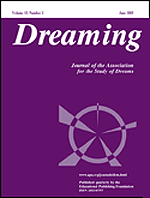 The April 2010 issue of the British film magazine Empire includes a feature in which I interpret the dreams of 14 movie actors and directors: Robert Downey, Jr., Kate Winslett, Peter Jackson, Milla Jovovich, Judd Apatow, Kristen Bell, Samuel L. Jackson, Steven Soderbergh, Marion Cotillard, Rachel Bilson, Robert Carlyle, Ray Winstone, and Sam Mendes.
The April 2010 issue of the British film magazine Empire includes a feature in which I interpret the dreams of 14 movie actors and directors: Robert Downey, Jr., Kate Winslett, Peter Jackson, Milla Jovovich, Judd Apatow, Kristen Bell, Samuel L. Jackson, Steven Soderbergh, Marion Cotillard, Rachel Bilson, Robert Carlyle, Ray Winstone, and Sam Mendes.
The editor and “dream wrangler” who gathered the reports, Nick de Semlyen, did not tell me who the dreamers were–all I had to work with were the dreams themselves.
Below are the full commentaries I sent in response, the “director’s cut” as it were. A pdf of the slightly shorter published article can be accessed here:
14 Weirdest Dreams in Hollywood
This method of blind analysis appeals to me because it strictly focuses one’s attention on the themes, symbols, and emotional dynamics of the dream itself, without prematurely seeking connections with the known details of the dreamer’s waking life. This was not a pure experiment, however, because I did know the dreamers were involved in the film industry in some way.
For more on the blind analysis”method of studying dreams, see the paper I recently co-authored with G. William Domhoff, “Detecting Meaning in Dream Reports: An Extension of a Word Search Approach,” which will appear in a forthcoming issue (June, I’m told) of the IASD journal Dreaming.
1) “My favourite dream is one I had in college, I was a homeless person on a bridge, wearing very tattered layers of clothing and the world was cast in this sepia tone and I was fishing with a piece of string off the bridge into the Thames for worms, and I would pull them out and put them in my mouth.”
(Gillian Anderson)
For many people college marks the transition to adulthood, when we leave our families and begin living on our own. Here the dreamer is cast as a homeless person, in a scene of apparent misery and hardship. As a metaphor, this could reflect the concerns a typical college student might feel about difficult life changes and, in a real sense, becoming “home-less.”
But much more seems to be going on. Consider the setting: the River Thames is the most historic waterway in Britain, an ever-flowing source of collective life and cultural power. The dreamer is sitting on a bridge that spans this epic river. She is connected to the water with a string, just as the bridge connects the two sides of land. It’s a remarkable image of elemental symmetry, with the dreamer positioned at the very center.
Then there’s the strange business of backwards fishing. Instead of taking worms from the earth and putting them into the river to go into the mouth of a fish, the dreamer pulls worms out of the river and puts them into her own mouth. It’s the complete reverse of normal fishing—as if she were the one being fished.
The dreamer probably didn’t know it, but the color sepia originally derived from the brownish ink produced by a certain species of fish (sepia means “cuttlefish” in Greek). Details like this may be just a coincidence, but sometimes they point to deeper unconscious meanings.
So this whole dream is enveloped in a strangely “fishy” atmosphere, with a superficial drabness masking a deeper structure and hidden purpose.
It sounds to me like the first chapter of a heroic myth: the youth who begins as the lowest of the low is drawing strength from the waters of her ancestors, getting ready to seek fame, fortune, and adventure out in the wide world.
2) “I had a really cool dream that I was doing a scene with the young Jack Nicholson. Five Easy Pieces era Jack. We were in the desert, with this really rad-looking ’70s car, and I was really killing this scene, being super-great in it. And then the wardrobe people came over and said ‘Oh my God, he’s wearing the wrong colour shirt’ and I was really upset — all this good work I’d done was ruined because Jack’s shirt wasn’t the right colour.”
(Millo Jovovich)
When people dream of celebrities it usually reflects some degree of psychological identification with the public personas of those famous people. The dreams envision us being in the company of powerful, talented people who embody the qualities and strengths we wish to possess ourselves.
When the theme of time travel enters the picture it suggests a quest for a deeper connection, something akin to what Australian Aborigines seek in the Dreamtime, when the ancestors still walked through a freshly created world. An actor’s version today might be something like this dream, going back to a legendary time when movie-making was a daring, creative adventure.
The dream turns into a nightmare, however, when the dreamer is confronted with the brutal fact of her lower status on the actor’s totem pole. No matter how good her work may be, her career is still vulnerable to the whims of bigger stars.
3) “I was standing under a huge tree — it must have been on the Serengeti, somewhere in Africa — and I was watching my family being eaten by lions. I had that dream over and over again when I was a kid… I’m guessing it came from some programme I saw on the telly. For that reason I’ve never been to Africa and I would never take my family there. Even now I’m shit scared of lions and when I go to the zoo I get the feeling that they can smell me and they’re plotting to get me. I’ll tell you how ridiculous my fear of them is: my daughter had to go to South Africa last year to do a film and I was begging her not to go. Because of the lions.”
(Ray Winstone)
One can imagine exactly the same nightmare being experienced by our human ancestors thousands of years ago when they actually lived on the Serengeti and had to worry about real lions attacking them. The instinctual imprint of that fear still echoes in the dreams of people today. A TV show might spark it, but the unconscious mind is already primed to raise the alarm. Even if they seem out of place in modern society, even if they seem entirely foolish and unreasonable, these hard-wired instincts still shape our perceptions of possible dangers in the world.
There might be something more to the symbolism of the lions for this dreamer, perhaps having to do with family aggression or masculine authority. The persistence of this fear from a childhood dream into adulthood makes me wonder if this is a person who, for better or for worse, puts great trust in his instincts and gut-level reactions.
4) “When I was nine years old, I dreamed I was a hippo in a ballerina skirt, like the one in Fantasia. It got worse, because I had to pee in my dream and when I woke up I’d wet my bed. That’s pretty embarrassing, right?
(Rachel Bilson)
It shouldn’t be. Bedwetting in childhood is fairly common, and certainly nothing to be ashamed of. A precocious desire to perform in the movies comes through in this dream, and also perhaps a warning that too much “fantasy” can interfere with impulse control and taking care of one’s basic physical needs.
5) “I’m coming into a modern city and the buildings are charging each other with electricity, like big Tesla coils. Then I go on a date with two twins and they kill me at the end. Analyse that.”
(Robert Downey, Jr.)
This sounds like the dream of a maniacal super-hero! Or someone with extraordinary creative talents he struggles to control. Or perhaps just someone who’s pulling our leg.
The vivid image of an electrically surging city, followed by the lustful fantasy of dating twins, leads to an abrupt end with the dreamer’s death. As a brief set of images, whether from a dream or not, it does accurately portray the up-and-down psychology of a manic episode. During such episodes the cognitive line between waking and dreaming can effectively disappear.
6) “I have this dream about falling all the time. People say that if you ever hit the ground in a falling dream you’ll have a heart attack and die. So I try to stay with the dream and see what happens. I’ve actually fallen from very high distances, hit the ground, gone through and ended up in water. But I can still breath and finally end up in air again. Then I start flying. It’s a very cool dream; I kind of look forward to it now.”
(Samuel L. Jackson)
To actually die in a dream, rather than waking up just a moment before death, is indeed unusual. When it occurs it tends to be very memorable and thought-provoking.
One of the general functions of dreaming is to expand our conscious sense of possibility and keep our minds flexible, adaptive, and open to alternative perspectives. In this case the dreamer pushes the process further than most people are willing to go. In many religious traditions these would be considered mystical experiences, and the dreamer might be taken aside for special training as a healer or shaman.
Some research has suggested that people who can guide their dreams like this have better physical balance and spatial coordination in waking life. Perhaps this dreamer is a dancer or an athlete of some kind?
7) “The recurring one from my childhood was the witch of the west walking up my road, bending each lamp post over and blowing out each lamp one by one as she got closer and closer, and when she blew out the last lamp I woke up…like wailing. It happened over and over again.”
(Sam Mendes)
Recurring dreams from childhood often stem from problems and conflicts destined to last a lifetime. Sometimes the dreams have a personal context, but often they draw upon collective images that express the shared concerns of all humankind (what Jung called “archetypes”).
I don’t know anything about the dreamer’s personal life, but his nightmares reveal a painful truth: death is coming to get us. The reference to the Witch of the West from “The Wizard of Oz” indicates an early turn to movies as a refuge from this fear. Movies offer the fantasy of immortality—if death is cast as the wicked witch, perhaps the dreamer can be like Dorothy and escape her clutches.
Although it might seem cruel for a child to be confronted so early with the dark specter of mortality, such dreams mark a valuable step in the development of mature consciousness. Most of the world’s religious traditions regard an acceptance of death as the key to true wisdom.
 A new article I co-authored with Bill Domhoff is appearing in the latest issue of the APA journal Dreaming (vol. 20, no. 2, pp. 77-95). The abstract is below.
A new article I co-authored with Bill Domhoff is appearing in the latest issue of the APA journal Dreaming (vol. 20, no. 2, pp. 77-95). The abstract is below.

 The April 2010 issue of the
The April 2010 issue of the  Dominican University’s Albertus Magnus Society will present a lecture titled “Sleep, Dreaming, and Human Health” by Dr. Kelly Bulkeley, visiting scholar at the Graduate Theological Union in Berkeley, California, on Thursday, February 11 at 7:00 p.m. The lecture will be held in Priory Campus Room 263, 7200 W. Division Street, River Forest. The event is free and open to the public.
Dominican University’s Albertus Magnus Society will present a lecture titled “Sleep, Dreaming, and Human Health” by Dr. Kelly Bulkeley, visiting scholar at the Graduate Theological Union in Berkeley, California, on Thursday, February 11 at 7:00 p.m. The lecture will be held in Priory Campus Room 263, 7200 W. Division Street, River Forest. The event is free and open to the public.